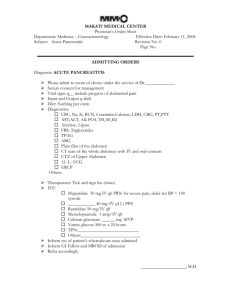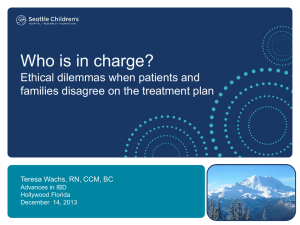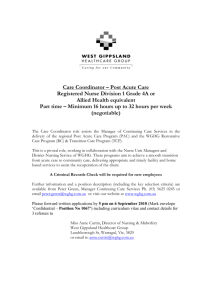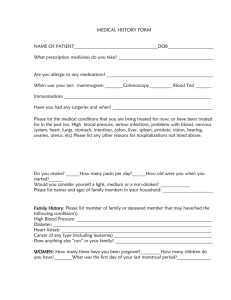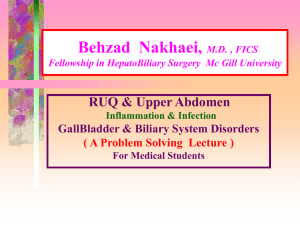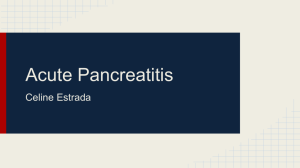saunders_gi
advertisement
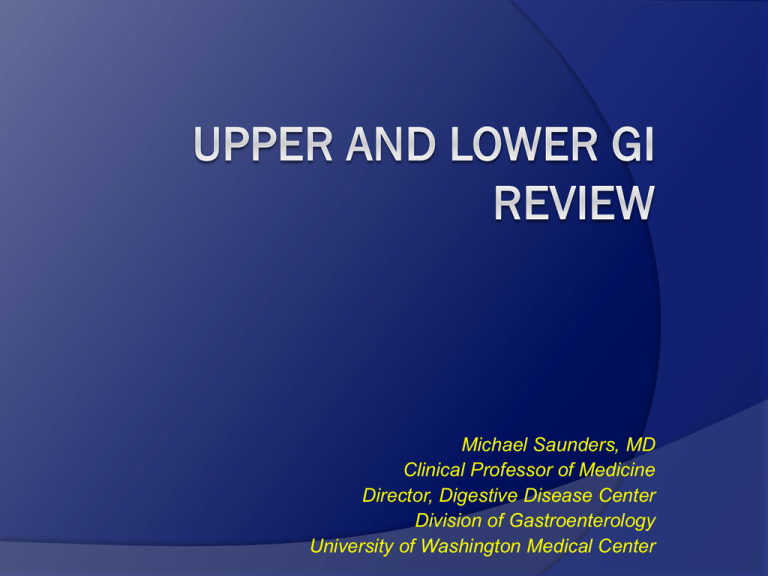
Michael Saunders, MD Clinical Professor of Medicine Director, Digestive Disease Center Division of Gastroenterology University of Washington Medical Center Case 1 Endoscopy 36yo male with chronic dysphagia and multiple food impactions (earliest at age 6) Ongoing dysphagia Constant, primarily solids has to drink water with bread to get it to go down Last food impaction 3 months ago No heartburn PmHx includes asthma and ectopic dermatitis Correct statements regarding this condition include which of the following? a) Typically affects white, middle-aged men b) High prevalence of co-existing allergic disorders (allergic rhinitis and asthma) c) Characterized by eosinophilic infiltration of the mucosa (>15-20 eosinophils/hpf) d) Corticosteroid therapy produces symptomatic, endoscopic and histologic improvement in the majority of patients e) All of the above Approach to dysphagia Eosinophilic esophagitis (EoE): Chronic inflammatory disorder of the esophagus characterized by eosinophilic infiltration of the mucosa >15-20 eosinophils/hpf Presenting symptoms: dysphagia (>90%) food impaction (62%) heartburn (25%) children: vomiting, regurgitation, abd pain In adults, typically presents in white, middle-aged men (average age 38) High prevalence of allergies (allergic rhinitis and asthma) in both pediatric and adult EoE pts Suggests food allergies may play a role in pathogenesis EoE: Treatment Systemic or topical corticosteroids produces symptomatic, endoscopic and histologic improvement/resolution in the majority of pts sxs and eos return w/in 3–6mo after d/c endoscopic dilation Allergy testing dietary therapy Elimination diet leads to symptom and histologic improvement Most common identified food triggers: ○ milk, wheat, soy, egg J Clin Gastroenterol. 2010 ;44(1):22-7; Gastroenterol 2012; 142:1451 A 53 year old female with chronic GERD presents to establish care. Her symptoms are completely resolved on PPI therapy. You recommend continued therapy with a PPI. The patient inquires about long-term efficacy and safety of PPIs. Which of the following statements is correct? a) b) c) d) Co-administration with clopidrogel should be avoided due to increased risk of cardiovascular outcomes Therapy should be limited to 6 months as there is gastric atrophy with an risk of adenocarcinoma in long-term users PPI therapy may be associated with an increased risk of infections in hospitalized patients Long term therapy should be avoided due to the increased risk of hip fracture with long term use Safety of PPI’s Concern Reality Gastric cancer No atrophic gastritis, metaplasia or dysplasia Infections Slight risk of dysentery during foreign travel risk of C. diff ↑ infections in cirrhotic patients B12 malabsorption No cases of Pernicious anemia Osteoporois No bone density changes or calcium malabsorption evident in prospective trials Hypomagnesemia Rare, clinical significance uncertain Reduced effectiveness of clopidrogel Conflicting data No association with adverse events in prospective studies Fioca et al. Aliment Pharm Ther 2012;36:959; Brunner et al. Aliment Pharm Ther 2012; 36:372007; 5:1418; Bajaj et al. Aliment Pharmacol Ther 2012; 36:866 Calcium and acid secretion Acid facilitates the release of ionized calcium from insoluble calcium salts gastrectomy and pernicious anemia are linked to increased risk of osteopenia and fracture Calcium carbonate absorption decreases at higher pH People with achlorhydria have decreased absorption of calcium carbonate on an empty stomach Absorption is normal when calcium carbonate is ingested with a meal Therapy with a full dose of omeprazole did not reduce the absorption of calcium contained in milk and cheese in normal controls In vitro osteoclast activity impaired by PPIs Yang and Metz. GASTROENTEROLOGY 2010;139:1115–1127 Is acid reducing therapy associated with risk of hip fracture? Data is confusing at best likely due to confounding variables No convincing data available that PPI’s decrease calcium absorption or bone density Premature to avoid prescribing acidreducing agents to those who have a clear indication Weigh risk of fracture to benefit of acid suppression Yang and Metz. GASTRO 2010;139:1115–1127 11/17/09 Press Release “Until further information is available FDA recommends the following: Healthcare providers should re-evaluate the need for starting or continuing treatment with a PPI, including Prilosec OTC, in patients taking clopidogrel. Patients taking clopidogrel should consult with their healthcare provider if they are currently taking or considering taking a PPI, including Prilosec OTC. “ Clopidogrel and the Optimization of Gastrointestinal Events Trial (COGENT) Probability of Remaining Free of Primary Cardiovascular events Bhatt et al. N Engl J Med 2010;363:1909-17 Clopidogrel and the Optimization of Gastrointestinal Events Trial (COGENT) Probability of Remaining Free of Primary Gastrointestinal Events Bhatt et al. N Engl J Med 2010;363:1909-17 The potential of PPIs to attenuate the efficacy of clopidogrel could be minimized by the use of dexlansoprazole or lansoprazole Frelinger et al. J Am Coll Cardiol 2012;59:1304–11 Which of the following statements pertaining to esophageal cancer and GERD are correct? a) b) c) d) The incidence of esophageal cancer is rising, surpassing that of colon cancer. Approximately 10% of patients with chronic GERD develop esophageal cancer Acid suppression and antireflux surgery do not eliminate BE or its cancer risk Most patients with Barrett’s esophagus will present with chronic GERD symptoms and be detected at upper endoscopy Incidence of Esophageal Adenocarcinoma In 2009, ~16,400 new cases of esophageal cancer 60% adeno- carcinomas 5-year survival rate, 15 to 20% Sharma. N Engl J Med 2009;361:2548-56 Barrett’s esophagus premalignant lesion detected in the majority of patients with esophageal adenocarcinoma Occurs in ~10% of patients having endoscopies for chronic GERD The reported incidence of Barrett’s esophagus is rising Risk factors include advanced age, male sex, white race, symptoms of reflux, and obesity 30 fold risk of esophageal cancer Acid suppression/antireflux surgery do not eliminate BE or its cancer risk Sharma. N Engl J Med 2009;361:2548-56 What is the best estimate of annual risk for developing adenocarcinoma with Barrett’s esophagus? a) b) c) d) e) 100% 50% 25% 5% 0.5% How often does non-dysplastic Barrett’s (NDBE) progress to cancer? Incidence of Dysplasia and EAC in 1204 patients with NDBE1 Diagnosis No. of cases Incidence rate Mean time to development LGD 217 3.6% 4.59y HGD 32 0.48% 5.6y EAC 18 0.27% 5.297 HGD/EAC 42 0.63% 5.41y the annual incidence of EAC would need to be >1.9% per year for surveillance of NDBE at 5-year intervals to be cost-effective2 low rate of progression to cancer reinforces the current expert consensus that routine endoscopic ablation of NDBE is not justified 1-Wani et al. Clin Gastroenterol Hepatol 2011 Mar; 9:220; 2 – Inadomi et al. Ann Intern Med 2003; 138:176 Incidence of Cancer in Barrett’s dysplasia Mean annual incidence <0.5% Paulson, Reid. Cancer Cell. 2004 Jul;6(1):11-6. Management of Barrett’s esophagus Sharma. N Engl J Med 2009;361:2548-56 Management of Barrett’s dysplasia *HGD should be treated Sharma. N Engl J Med 2009;361:2548-56; Spechler et al. Gastroenterol 2011 Endoscopic treatments for Barrett’s esophagus Endoscopic mucosal resection (ER)* Radiofrequency ablation (RFA)* Photodynamic therapy (PDT)* Cryotherapy Other (argon plasma coagulation, multipolar electrocautery, laser) * Prospective data available EMR in early esophageal cancer Radiofrequency ablation (RFA) Multi-modality therapy for early Barrett’s neoplasia: endoscopic resection followed by radiofrequency energy ablation. Case Presentation An 52-year-old woman with sudden onset of epigastric/RUQ pain PE: temp 37.0 C; HR 90, BP 110/70 mm Hg; no scleral icterus; Abdominal exam reveals mild RUQ tenderness without guarding or rebound Labs: WBC 12,000; aminotransferases: AST 935 ALT 1346; alk phos 98 , amylase 143, bilirubin (total) 1.8 abd u/s reveals a CBD 9 mm; No gallstones pericholecystic fluid are noted What is the most likely diagnosis? 1. 2. 3. 4. 5. Acute viral hepatitis Ischemic hepatitis Acute common bile duct obstruction Acute pancreatitis Acute cholecystitis Differential diagnosis of acute transaminase elevation > 1000 Viral hepatitis Toxin/drug Ischemia Acute CBD obstruction (stone) Biliary tract stone disease •Cholelithiasis : •symptomatic cholelithiasis •acute cholecystitis •Choledocholithiasis •symptomatic CBD stone • cholangitis •pancreatitis An 82-year-old woman presents with sudden onset of right upper quadrant abdominal pain, fever, and shaking chills. PE: temperature is 39.0 C (102.2 F). Pulse rate is 110 per minute, and blood pressure is 90/70 mm Hg. Slight jaundice is noted. Heart and lungs are normal. Abdominal examination reveals mild right upper quadrant tenderness without guarding or rebound. Mental status is normal. Leukocyte count 12,000 ; AST 235 ALT 343, alkaline phosphatase 298 , amylase 78, bilirubin (total) 4.5 Abd u/s : common bile duct measuring 15 mm in diameter; distended gallbladder with sludge, no pericholecystic fluid or stones are noted. The most likely diagnosis is? 1. 2. 3. 4. Acute cholangitis Acute cholecystitis Perforated peptic ulcer disease Acute mesenteric ischemia 25% 1 25% 25% 2 3 25% 4 Cholangitis - infection in biliary tree Cholangitis requires: • Bacteria (Bile is normally sterile) Source of bacteria in bile: • intestinal translocation and portal bacteremia • reflux from duodenum • gallbladder/stones • Obstruction of biliary tract Death may result within hours of presentation Associated with significant morbidity/mortality Early recognition and treatment are essential Urgent biliary decompression Acute cholangitis: Clinical Presentation and diagnosis Charcot’s Triad (~70%): • Abdominal pain • Fever • Jaundice Labs: Leukocytosis Abnormal LFT’s Blood cultures Imaging: Ultrasound/CT scan - choledocholithiasis (<50%) - biliary dilation (~75%) Case (continued) Broad spectrum ABx are begun, but the patient develops rigors after receiving the initial dose. Temperature is now 39.6 C (103.3 F). Pulse rate is 120 per minute, and blood pressure is 82/60 mm Hg. She appears slightly confused. Which of the following is most appropriate now? 1. 2. 3. 4. Continuation of antibiotic regimen with the addition of imipenem Immediate ERCP with biliary drainage Immediate percutaneous transhepatic cholangiography and external biliary drainage Immediate surgery Management of Cholangitis • Volume resuscitation • Antibiotics (Pip/Tazo, Amp/Sul, Ticar/Clav, 3o Ceph, Imipenem, Levofloxacin, Cipro) • Biliary decompression Timing Route (ERCP > PTC > Surgery) Case Presentation 45 yo man developed acute onset of epigastric pain requiring transport via ambulance to the ER PMHX: unremarkable. No chronic meds. No EtOH. Exam: T 38.0, BP 150/100, HR 110 Moderate distress, in obvious discomfort mod-severe tenderness with guarding, distention, hypoactive BS, no peritoneal signs LABS: WBC 20,000, Hct 50, BUN 60, Cr 2.2, AST 350, ALT 460, Total Bilirubin 5.0, Alk phos 270, Amylase 1200 The most likely diagnosis is? Acute mesenteric ischemia 2. Acute cholecysitis 3. Acute pancreatitis 4. Small bowel obstruction 5. Rupture abdominal aortic aneurysm 1. Diagnosis of acute pancreatitis Clinical (requires 2 of the following): Characteristic epigastric pain Elevated pancreatic enzyme levels (>3x upper limits of normal) Abnormal imaging (inflammatory changes in pancreas) Evaluation of acute pancreatitis Edematous/Interstitial (IP) vs. Necrotizing (NP) Organ failure in 15% compared with 80% The most likely cause of the pancreatitis is? Alcohol abuse b) Gallstones c) Hypertriglyceridemia d) Trauma e) idiopathic a) Etiology of acute pancreatitis Obstructive Toxins/drugs Metabolic Infection Vascular Trauma Idiopathic ALT 3x normal has a 95% PPV for biliary pancreatitis Am J Gastro 1994; 89:1863 The most appropriate management of the patient includes? 1. 2. 3. 4. 5. Admission to the ICU Aggressive volume resuscitation Empiric broad spectrum antibiotics Urgent ERCP for biliary decompression All of the above 20% 1 20% 20% 2 3 20% 4 20% 5 Principles of treatment of acute pancreatitis • Intravascular volume • Analgesia • Put pancreas to "rest" • Treat complications–pulmonary, shock, renal, metabolic • ERCP for biliary obstruction/cholangitis • Antibiotics for severe disease • Percutaneous aspiration of pancreas to document infection in patient who fails to respond • Drainage/debridement for infected necrosis Step up approach for necrotizing pancreatitis 17 (40%) Open necrosectomy 31 (69%) Minimally invasive step-up approach 17 (40%) Major complications/death N Engl J Med. 2010;362(16):1491 Management of Severe Acute Pancreatitis Clinical Assessment of severity Severe Contrast-enhanced CT scan > 30% necrosis Mild Supportive therapy < 30% necrosis Antibiotics (imipenem) Improvement Yes Continue ABX for 7-14 days No CT guided aspiration Yes Infected Percutaneous, endoscopic and/or surgical debridement No Continued supportive therapy True statements regarding celiac disease include all of the following except? 20% 1. 2. 3. 4. 5. 20% 20% 2 3 20% 20% The prevalence in the U.S. is 1:300 Diagnosis requires a compatible small bowel biopsy with clinical response to gluten withdrawal Tissue transglutaminase IgA is the most sensitive serologic test Is strongly associated with HLA DQ locus Serologic tests are not affected by dietary gluten restriction 1 4 5 Answer 5 Pearls: 20% of patients > 60 years at diagnosis HLA-DQ2 and/or DQ8 > 95%* IgA tissue transglutaminase and endomysial antibodies have sensitivities and specificities > 95% Anti-gliadin non specific (PPV ~30%) Levels fall with adherence to gluten-free diet *Kaukinen et al. Am J Gastroenterol 2002 Case presentation 67 yo male w/ 2-3 days of increasing abdominal pain, distention, fever, and non-bloody diarrhea Admitted to ICU 2 weeks earlier for urgent cardiac bypass Course complicated by bacterial pneumonia with respiratory failure Temp 38.5, WBC 16,000 The most appropriate management includes? 20% 1. 2. 3. 4. 5. 20% 20% 2 3 20% 20% Neostigmine IV Surgical resection Colonoscopy Empiric antibiotics with oral vancomycin and IV metronidazole Fecal transplantation 1 4 5 Pseudomembranous colitis Differential diagnosis of nosicominal diarrhea Medications (antibiotics!) Infectious (C. diff) Dietary (tube feedings) Ischemic colitis Clostridium difficile infection Rate of hospital acquired C. diff is ~3% Incidence of refractory cases and multiple relapses is rising Probiotics prevent CDAD Fecal transplantation: associated with 94% cure rate safe and effective treatment for refractory C. difficile infection Johnson et al. Ann Intern Med 2012; 13. Mattila et al. Gastroenterol 2012; 142:490 67 year old male from a NH with prior CVA and COPD is admitted for treatment of pneumonia with antibiotics. He has been receiving tube feedings via a PEG placed 3 months ago. After 5 days of IV abx he develops watery, non-bloody diarrhea, low grade fever, and elevated WBC count (32 K). Stool is positive for fecal leukocytes. C difficile toxin A is negative, but antigen is positive. What is the most likely explanation for his clinical findings? a) b) c) d) He is a carrier for C difficile He has uncomplicated antibiotic-associated diarrhea He has toxin A (-), B (+) C difficile His diarrhea is due to hyperosmolar tube feeds Answer C Pearls: Many commericial EIA tests will test for toxin A and antigen 3-4% of C difficile strains produce toxin B only Elevated WBC, fecal leukocytes, and fever suggest C difficile infection Risk factors for infection include older age, use of antibiotics, PPI’s, and virulent NAPI strain Johnson et al. J Clin Microbiol 2003; 41:1543-1547 Loo et al. N Engl J Med 2011; 365:1693 57 year old male with long-standing diabetes mellitus type 1 presents with over 5 years of daily diarrhea and weight loss (35 lbs). His course has been complicated by poor glucose control and peripheral neuropathy. A quantative stool collection yielded a fecal fat output of 24g/24h. Possible causes for this picture include all of the following except: a) Diabetic enteropathy Excessive sorbitol ingestion Small bowel bacterial overgrowth Celiac disease Pancreatic exocrine insufficiency b) c) d) e) Answer B Diarrhea is a frequent complication of long standing IDDM, occurring in ~ 20% Bacterial overgrowth, celiac disease, and exocrine pancreatic insufficiency occur with a greater frequency in diabetics than in the general population Sorbitol produces an osmotic diarrhea without steatorrhea 24 year old female with a new diagnosis of Crohn’s disease after presenting with chronic abdominal pain, diarrhea and weight loss of 2 years duration Colonoscopy revealed moderate-severe terminal ileal and right colon disease True statements regarding management of her disease include which of the following? a) Therapy should be initiated with 5-ASA agents because of the favorable side effect profile b) Steroids are the treatment of choice for maintenance of remission in Crohn’s disease c) Therapy should be initiated with anti-TNF therapy as this has the greatest likelihood of achieving and maintaining remission d) No therapy for Crohn’s disease has been shown to improve long term outcomes and reduce need for surgery Disease Complications Goals of Therapy Have Expanded Induce and maintain gastrointestinal healing (Mucosal Healing) Prevent strictures and penetrating complications Prevent extra-intestinal complications Avoid/reduce corticosteroid use Decrease hospitalization Decrease surgery Decrease long-term cost Natural Course Years TREAT Mortality in Crohn’s disease Logistic Regression Data (Multivariate) Odds Ratio 95% CI P-Value Current use of infliximab 1.015 0.531-1.942 P=0.96 Current use of 6MP/AZA/MTX 0.731 0.398-1.340 P=0.31 Current use of corticosteroids 2.096 1.147-3.832 P=0.016 Current use of narcotic analgesics 0.946-3.379 1.787 P=0.74 Lichtenstein G et al. Clin Gastroenterol Hepatol. 2006;4:621-630. Top-Down vs. Step-Up Endoscopic Results 100 % of patients 80 73 P=0.0028 60 40 30 20 0 Step-up Top-down Complete endoscopic healing at 2 years D’Haens et al. Lancet. 2008;371:660-667. Key Messages: Early Intervention with Biologic Therapy Early intervention with immunotherapies improves likelihood of response/remission. Steroid sparing strategies early in the disease course are associated with mucosal healing Biologics are current best therapy for Crohn’s Disease Intervention with anti-TNF therapy improves outcomes in Crohn’s disease Which of the following are correct statements regarding the safety of medical therapy for Crohn’s disease? a) Long term therapy with anti-TNF should be avoid due to the risk of serious infections b) Long term therapy with anti-TNF should be avoided due to the risk of lymphoma c) Anti-TNF therapy is contraindicated in pregnancy d) Steroid use is the most important risk factor for serious infections in Crohn’s disease Risk of Serious Infections in Crohn’s Disease: Meta-Analysis of All Controlled Trials Anti-TNF Serious Infections Control 70 (2.09%) 43 (2.13%) Peyrin-Biroulet et al CGH 2008;6:664. 95% CI 0.45-0.65 TREAT Serious Infections Logistic Regression Data (Multivariate) Odds Ratio 95% CI P-Value Current use of infliximab 0.991 0.641- 1.535 P=0.97 Current use of 6MP/AZA/MTX 0.782 0.519- 1.179 P=0.24 Current use of corticosteroids 2.212 1.464-3.342 P<0.001 Current use of narcotic analgesics 2.380 1.560-3.631 P<0.001 Lichtenstein G et al. Clin Gastroenterol Hepatol. 2006;4:621-630. Key Messages: Risk/Benefit of Therapy in IBD Risks of therapy must be considered in the context of the risk of untreated disease and progression of disease. Steroids remain the most dangerous medical therapy for IBD. Lymphoma risk in IBD is associated with thiopurine therapy and concomitant therapy with biologics and thiopurines. Disease control at conception improves pregnancy outcomes anti-TNF therapies are safe during pregnancy A 35-year-old man asks your advice about screening for colon cancer. His father had colon cancer at age 61. An older brother had asymptomatic adenomatous polyps found on a screening colonoscopy at age 50. No other family members have had colon polyps or cancer. The patient has no gastrointestinal symptoms. Physical examination is normal. Which of the following should you recommend? (A) Screening for an average-risk individual beginning at age 50 (B) Fecal occult blood testing annually beginning at age 40; screening colonoscopy beginning at age 50 and every ten years thereafter (C) Screening colonoscopy beginning at age 40 and every five years thereafter (D) Screening colonoscopy beginning at age 40 and every ten years thereafter American College of Physicians (ACP) guidance statement for colorectal cancer (CRC) Average-risk individuals should begin screening at age 50 High-risk adults should begin at age 40 or 10 years younger than the age at which their youngest affected relative received a diagnosis of CRC. The screening for average risk: annual stool-based test, flexible sigmoidoscopy every 5 years or optical colonoscopy every 10 years Optical colonoscopy every 5 years in high-risk patients. Clinicians should select the test based on the benefits and harms of the screening test, availability of the test, and patient preferences. Clinicians should stop screening for CRC in adults >75 or with a life expectancy of <10 years. Screening in blacks is appropriate beginning at age 40 Ann Intern Med 2012 Mar 6; 156:378 Screening for Persons with Familial Risk Familial risk category Recommendation* Second or third degree relatives with colorectal cancer Same as average risk First-degree relative with colon cancer or polyps diagnosed at age 60 yr Same as average risk but begin at age 40 yr Two or more first degree relatives with colon cancer, or first degree relative with colon cancer or polyps diagnosed at age < 60 yr Colonoscopy q 5 yr, begin at age 40 yr or 10 yr younger than earliest diagnosis in family * Synthesis of guidelines from Multidisciplinary expert panel and ACS A 55-year-old man has a history of a 0.5-cm pedunculated tubular adenoma removed a screening colonoscopy 5 years previously. A follow up colonoscopy is normal with no polyps evident. When should you recommend that the next surveillance colonoscopy be performed? a) b) c) d) e) In 6 months In 1 year In 3 years In 5 years In 10 years Recommendation for Surveillance Colonoscopy in Patients with Neoplasia Most serious baseline exam findings 1-2 small adenomas (<10 mm) 3 or more small tubular adenomas Advanced adenoma Recommended surveillance interval 5 years or more Cancer, post-resection 1 year, then every 3-5 years 3 years 3 years Lieberman. Gastroenterol 2004; 126:1167 New guidelines for postpolypectomy surveillance after colonoscopy Intervals are now based on results not only from most recent exam but also from baseline exam that identified neoplasia Patients with low risk findings at baseline, and no subsequent adenomas on surveillance should be returned to average risk with next surveillance at 10 years Lieberman et al. Gastroenterol 2012; 143:844 Common mistakes made in colon cancer screening/surveillance Restarting annual FOBT after normal screening colonoscopy What constitutes a worrisome family hx Under utilization of surveillance in high risk subjects ~50-60% of patients with advanced baseline findings had f/u exam at 5 years Over utilization of surveillance in low risk subjects ~25% with no polyps had f/u exams within 5 years Inappropriate f/u for non neoplastic (hyperplastic) lesions Schoen et al. Gastroenterol 2010; 138:73
